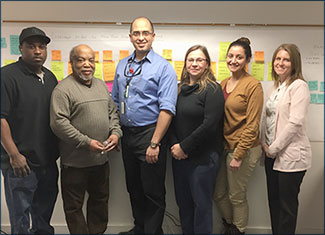
Finished Goods Strategy
Finished Goods Strategy Helps Medical Device Manufacturer Meet Delivery Commitments
DPA’s Kaizen team recently helped a medical device manufacturer implement a finished goods strategy to reduce lead times and satisfy delivery commitments to its customers.
The manufacturer needed to find out what was causing delays in getting orders to production. To improve customer satisfaction, the company sought to reduce lead time from up to 12 weeks to a steady eight weeks. The company initially projected these lead-time savings would increase its parts production by 10% per year.
Assessing the Situation
DPA’s Kaizen leader worked with a team of six company employees to map the process from order to production start. Because the company doesn’t commit to a final delivery date until the customer inspects the first produced piece, the process was expanded to include the first-piece inspection.
Defining the Real Goal
After reviewing the current process, the Kaizen team found that the company’s lead time for an accurate commitment back to the customer was 11-33 days. Too much time was being spent processing paperwork, allocating materials, preparing tooling and generating a first good piece.
The team was very surprised to discover the longer-than-expected lead time to get to a delivery commitment. They set a goal to have an accurate commitment back to the customer in one to two days.
Creating Solutions
Based on their findings, the team developed a strategy to use finished goods inventory to deliver to the customer at a consistent lead time of eight weeks. They then calculated an achievable commitment back to the customer lead time by assigning a takt time based on previous years’ order history. This equated to eight sales orders per day. The next step: establish standard work that would ensure flow to takt time. The team divided the paperwork process into several logical steps and moved existing paperwork into six “buckets”.
To put the finished goods inventory in place and test out their idea, the team identified a pilot grouping of parts to put on kanban. They investigated the net inventory change and found it to be quite reasonable relative to the benefits of a better commit to the customer.
The kaizen team also observed how a better-organized tooling and repair operation would help smooth production. Currently, dies are run until they need significant repairs. This causes delays in the next job start. To keep the customer happy, extra parts produced during the last production run were given to the customer immediately upon request.
If a more consistent and strategic lead-time is applied and pulled from finished goods inventory, the production team will have up to a maximum of eight weeks to get the dies in great working order prior to the next production run, long before the customer is impacted.
This time buffer will help the company implement continuous improvement measures to begin reducing their actual lead time. The kaizen promotion office will then seek to make strategic improvements to actual lead times and adjust their finished goods inventory strategy once the improvements are in place.
Testing it Out
To provide visuals and triggers that would keep paperwork flowing at a rate of eight customer commitments per day, the kaizen team set up a flow sequence at the customer specialist’s desk. To ensure better linkage to the production capacity at the time of customer order receipt, the team also moved some of the work to the production liaison. Standard methods were established to come up with an accurate lead time for parts not yet on the finished goods strategy. The team ran a trial of their process and found that eight sales orders per day is achievable.
Final Benefits Exceed Initial Goal
The team successfully implemented continuous flow and workload leveling techniques in customer service. They also implemented a finished goods strategy where orders are shipped out of kanban at a consistent eight-week standard lead time. Using standard work, these actions helped the team achieve an 82% lead time reduction from order receipt to production start. The improved processes are expected to eliminate a $43,936.75 backlog and improve customer satisfaction. Finally, they will increase the discretionary time available in production to continually improve the process.
Improvement Never Stops
As a result of the Kaizen event it held with DPA, the team developed a list of 35 additional action items for improving the process lead-time, with dates and individuals assigned to each.


